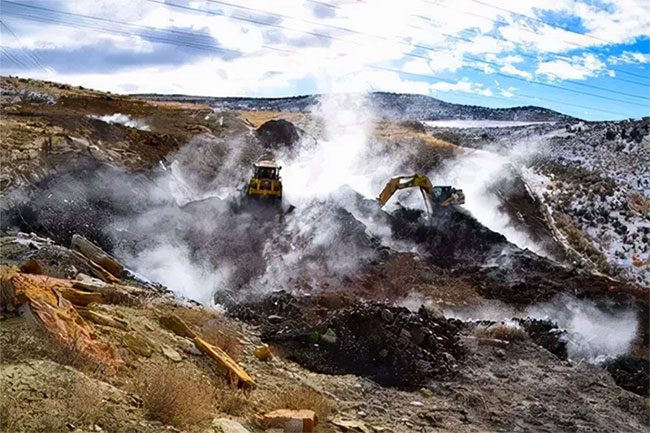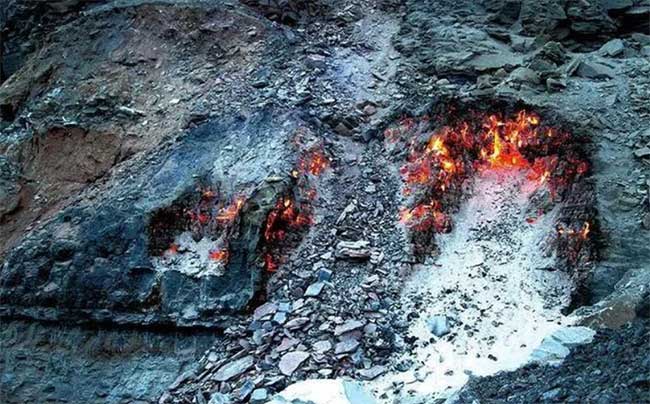This coal mine is likened to a real-life version of “Mount Doom,” and of course, the fire is not caused by the Eight Trigrams furnace.
Coal is the most abundant energy source on Earth, but its relatively low cost is due to large reserves, which is why it is referred to as cheap energy. With the development of the economy and the rate of coal consumption, people are beginning to realize the value of coal, as it takes a very long time to regenerate.
China is a country rich in coal reserves. In particular, Mount Halan (located between Ningxia and Inner Mongolia, China) has unique geological conditions, making the quality of coal here truly exceptional.
The coal here not only emits low levels of ash and sulfur but also produces almost no smoke and generates high heat. It can be said that coal from Mount Halan is a very ideal chemical material. Hence, it is dubbed the “King of Coal.”
The smoldering volcano for 300 years on Mount Halan
The coal on Mount Halan is precious, but its seams are being wasted through burning. Reports suggest that they have been self-igniting for 300 years, dating back to the Qing Dynasty. It is estimated that Mount Halan has burned over 34,000 tons of coal each year from spontaneous combustion, resulting in damages of up to 1 billion yuan annually.
According to statistics, the area of spontaneously igniting coal seams on Mount Halan spans up to 16 hectares, and the fire continues to spread. Many people express regret over this issue, as not only is money being wasted, but this precious coal resource is also being lost and cannot be regenerated.
The coal on Mount Halan has two notable characteristics: it has a high gas content and high reactivity. This feature makes it similar to a “fuse.” When the upper coal seams are naturally ignited, the temperature can easily reach deeper coal mines. When temperatures rise to 300-700°C, the coal in nearby areas will also ignite.
Moreover, historical records indicate that small furnaces or workshops for coal extraction have existed since ancient times. By 1990, mining activities in the Mount Halan area exploded, but the technology used at that time was increasingly inadequate.
Due to substandard mining practices, coal seams were exposed to the air, leading to reactions with oxygen and resulting in self-ignition. The area also has numerous voids created by excessive and haphazard mining. This is also part of the reason for the persistent fires that have been burning for 300 years.

The mining process continues unabated. (Photo: Sohu)
Deadly consequences
The continuous burning of coal not only releases harmful gases such as carbon dioxide, carbon monoxide, and nitrogen oxides but also directly kills living organisms in the surrounding area. This further deteriorates local air quality and impacts human health.
Statistics indicate that the area of spontaneous combustion at Mount Halan emits 12,900 tons of particulates and 5,324 tons of carbon dioxide annually. Such emissions are 269 times greater than those from a thermal power plant. Reports suggest that local residents have higher rates of respiratory, digestive, and cancer-related diseases compared to other areas.
Furthermore, the mining-induced voids are prone to landslides, rock fractures, and subsidence. Coupled with the depletion of the land, many organisms near the mining area cannot survive, and much vegetation has died, exacerbating soil and water erosion during the rainy season.
Why can’t the fire at Mount Halan be extinguished?
According to statistics, from 2012 to 2015, China experienced nearly 20 large-scale gas explosions at Mount Halan, with up to 9 incidents caused by spontaneous coal seams, resulting in significant human casualties. The smoldering fire here has caused severe damage every year and has persisted for over 300 years, yet it remains uncontrolled. The reason is not due to a lack of desire but rather a “powerless situation.”
First of all, coal at Mount Halan is very flammable. Therefore, the fire can easily spread to adjacent coal seams. This situation leads to an increasing number of spontaneously combusting coal seams, making it very unlikely that the fire can be extinguished.

Coal continues to burn every day. (Photo: Sohu)
Additionally, intensive coal mining has accelerated the exposure of coal seams. As the contact surface between underground coal seams and oxygen increases, the risk of ignition rises. Due to improper mining practices, the interior of the mountain has been hollowed out. These voids provide oxygen to deeper coal seams. Most of these fires are inaccessible.
Moreover, the mountain has been mined from many directions, leading to numerous voids. It is impossible to seal these voids to prevent oxygen from entering.
Furthermore, the method of extinguishing self-igniting coal is quite unique. We cannot extinguish it by spraying water like a typical fire, as coal comes into contact with water and produces hydrogen, which can easily lead to explosions. To date, no safe and reasonable method for extinguishing these fires has been found.
Coal is already a valuable resource that is gradually depleting. To protect ourselves and future generations, we need to take further action to preserve these resources for the future.


















































